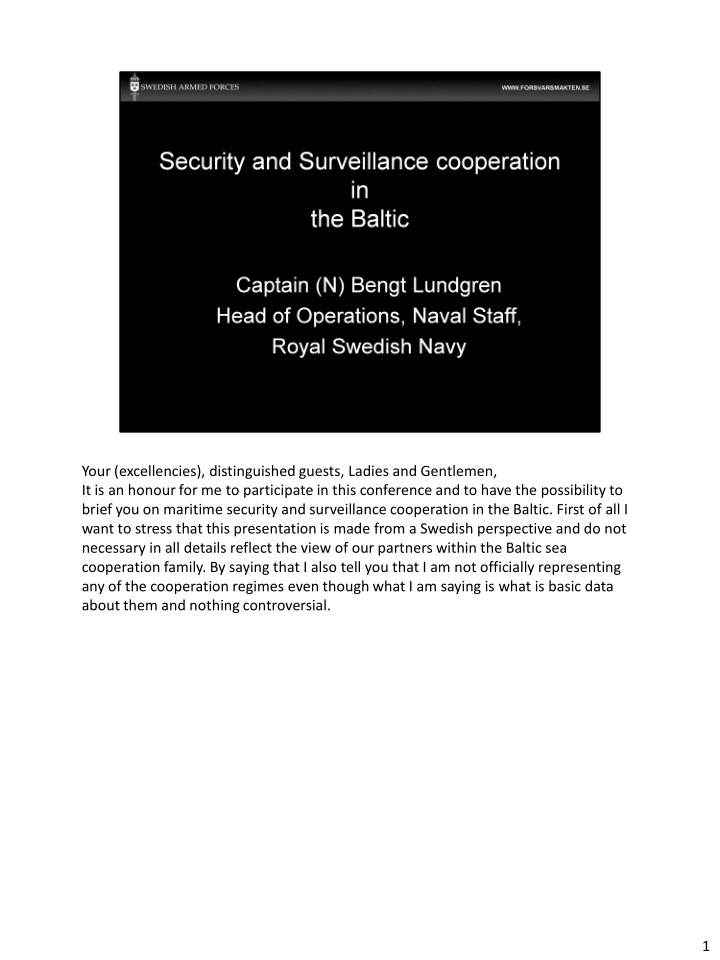



Your (excellencies), distinguished guests, Ladies and Gentlemen, It is an honour for me to participate in this conference and to have the possibility to brief you on maritime security and surveillance cooperation in the Baltic. First of all I want to stress that this presentation is made from a Swedish perspective and do not necessary in all details reflect the view of our partners within the Baltic sea cooperation family. By saying that I also tell you that I am not officially representing any of the cooperation regimes even though what I am saying is what is basic data about them and nothing controversial. 1
I will start with some facts about the Baltic region from both a general and a national Swedish perspective. I will also mention some issues about the different threats in our region and the transformation of Sweden's approach from cold war isolation to todays full European and regional cooperation approach Further more, I will try to explain for you where we are today and what we have achieved since the start of the Swedish-Finnish cooperation more than 15 years ago. Finally I will make some remarks about necessary developments, the future and all the possibilities that are ahead of us. 2
There are over 90 million people living around the Baltic Sea, with 9 coastal states and one Russian enclave. It is mostly NATO and EU territory except the Russian national waters. The sea itself is a brackish inland sea, making it a difficult sub-sea environment for both military and civilan exploration and purposeses, but it is also a very special environment for fish and even isolated populations of arctic species which have remained in the Baltic Sea since the last glaciation. It’s an unique maritime environment well worth to protect. 3
It is an environment that also shifts considerably from summer to winter with huge temperature differences. Some years, like 1987, the entire Baltic Sea was frozen and pack ice reached the thickness of several meters. Today ice- breaking is another area of cooperation around the Baltic Sea. 4
The importance of the Baltic Sea as a trade route can not be overestimated. Over 90 % of all trade in Sweden is dependent on our Sea Lines of Communication. This includes both export and import traffic as well as a network of domestic shipping lines along the Swedish coastline. There are between 2 – 4000 sizeable ships in the Baltic Sea at any given moment, 365 days a year. 5
A big proportion of those ships are transporting oil. With more ships in the area, the risk for accidents increases and taken in consideration that there are still a lot of single hull ships in the region, also risks for severe environmental disasters. As you all are very well aware off, the consequence of an accident at sea not only strikes the ship itself, but also the Sea and the coastlines adjacent to the accident. 6
Last year it was 100 years ago since Titanic sank, where 68% of the passengers perished, for us it is a much closer memory and still a national trauma when M/S Estonia sank where 86 % of passengers and crew died and only 137 out of 989 could be rescued. I don’t think anyone argue that search and rescue cooperation is definetely something that have to be improved in the future for better use of national resources for common good. 7
If you had asked me when I started in the navy in the early 1980’s, what type of threats that existed in the Baltic I would have told you all the high end threats. I am referring to military air-, surface and underwater threats. Today things are different, but don’t forget that those threats were the reason for building up sea surveillance capabilities and that military sensors used for this today can be used for other purposes as well. 8
After the cold war ended, now also low end threats emerged in a new way and on the slide one can see some of them. They were all mentioned yesterday in the FRONTEX briefing. All the threats against security do not need to be as drastic as a big accident or an armed attack, but still have tragic effect. 9
In the Baltic Sea the constantly increasing traffic and other maritime activities means new possibilities, for development and an increased economic growth. The increasing traffic and increasing maritime activities also as I earlier stated, brings forward new threats and risks for the surrounding states. For us, it has been important to push forward the development of such capabilities and cooperation's that gives us a possibility to meet these challenges and to take our share of the common responsibility to create a secure and safe environment for all maritime activities in the Baltic Sea and its approaches.
Recommend
More recommend